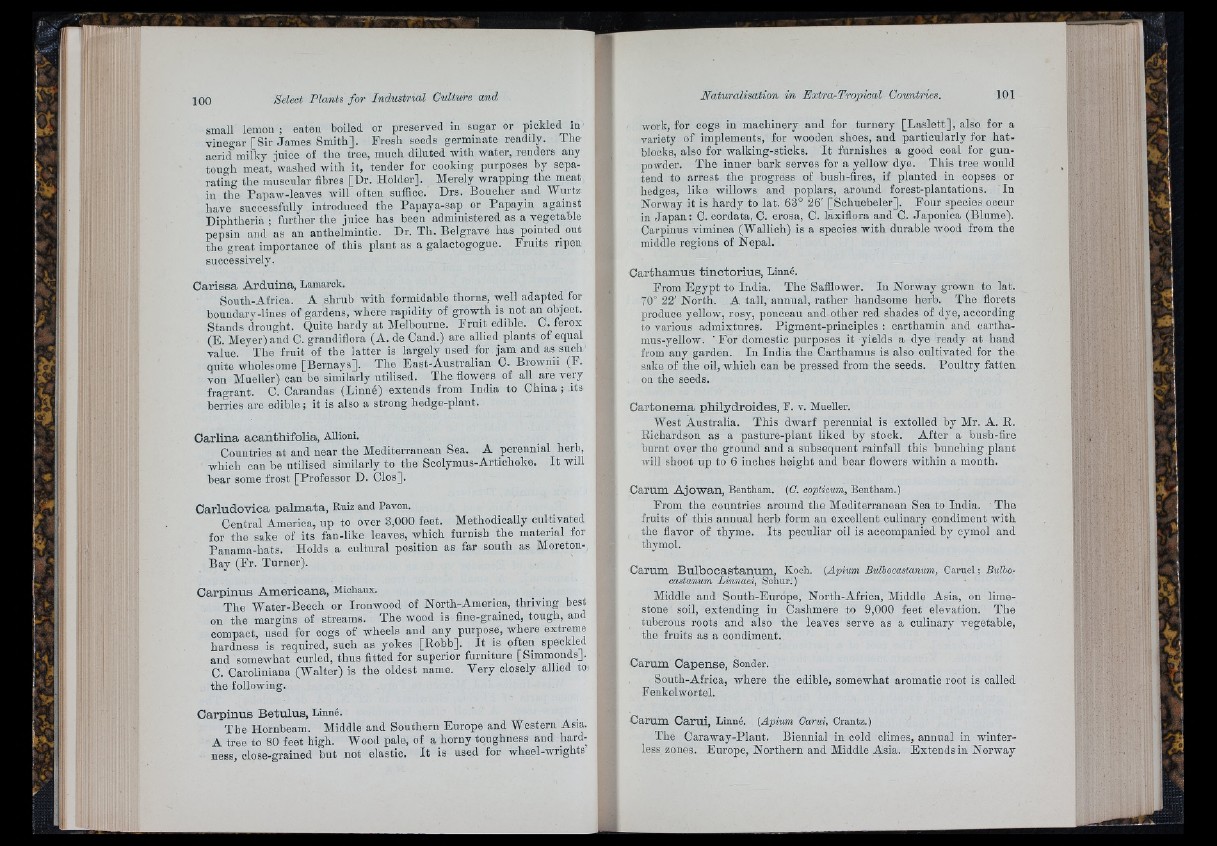
small lemon ; eaten boiled or preserved in sugar or pickled in
vinegar [S ir James Smith]. Fresh seeds germinate readily. The
acrid milky Juice of the tree, much diluted witii water, renders any
tough meat, washed with it, tender for cooking purposes by separating
the muscular fibres [Dr. Holder]. Merely wrapping the meat
in the Papaw-leaves will often suffice. Drs. Boucher and Wurtz
have successfully introduced the Papaya-sap or Papayin against
Diphtheria ; further the juice has been administered as a vegetable
pepsin and as an anthelmintic. Dr. Th. Belgrave has pointed out
the great importance of this plant as a galactogogue. Fruits ripen
successively.
C a r is s a A r d u in a , Lamarck.
South-Africa. A shrub with formidable thorns, well adapted for
boundarv-lines of gardens, where rapidity of growth is not an object.
Stands drought. Quite hardy at Melhonroe. Fruit edible. C. ferox
(E. Meyer) and C. grandiflora (A. de Cand.) are allied plants of equal
value. The fruit of the latter is largely used for jam and as such
quite wholesome [Bernays], The East-Australian C. Brownii (F.
von Mueller) can be similarly utilised. The flowers of all are very
fragrant. C. Carandas (Linné) extends from India to China ; its
berries are edible ; it is also a strong hedge-plant.
C a r lin a a o a n th ifo lia , Allioni.
Countries at aud near the Mediterranean Sea. A perennial herb,
which can he utilised similarly to the Scolymus-Artichoke. I t will
hear some frost [Professor D. Clos].
C a r lu d o v i c a p a lm a t a , Buiz and Pavon.
Central America, up to over 3,000 feet. Methodically cultivated
for the sake of its fan-like leaves, which furnish the material for
Panama-hats. Holds a cnltural position as far south as Moreton-
Bay (Fr. Turner).
C a r p in u s A m e r ic a n a , Michaux.
The Water-Beech or Iroiiwood of North-America, thriving best
on the margins of streams. The wood is fine-grained, tough, and
compact, used for cogs of wheels and any purpose, where extreme
hardness is required, such as yokes [Robb]. I t is often speckled
and somewhat curled, thus fitted for superior furniture [Simmonds].
C. Caroliniana (Walter) is the oldest name. Very closely allied to
the following.
C a r p in u s B e tu lu s , Linné.
The Hornbeam. Middle and Southern Europe and Western Asia.
A tree to 80 feet high. Wood pale, of a horny toughness and hardness,
close-grained but not elastic. I t is used for wheel-wrights
work, for cogs in machinery and for turnery [L a sle tt], also for a
variety of implements, for wooden shoes, and particularly for hat-
blocks, also for walking-sticks. I t furnishes a good coal for gunpowder.
The inner bark serves for a yellow dye. This tree would
tend to arrest the progress of bush-fires, if planted in copses or
hedges, like willows and poplars, around forest-plantations. In
Norlvay it is hardy to lat. 63° 26' [Schuebeler], Four species occur
in Jap an : G. cordata, C. erosa, C. laxiflora and C. Japónica (Blume).
Carpinus viminea (Wallich) is a species with durable wood from the
middle regions of Nepal.
C a r th am u s t in c t o r iu s , Linné.
From E gypt to India. The Safflower. In Norway grown to lat.
70° 22' North. A tall, annual, rather handsome herb. The florets
produce yellow, rosy, ponceau and other red shades of dye, according
to various admixtures. Pigment-principles : carthamin and cartha-
mus-yellow. ' For domestic purposes it yields a dye ready at hand
from any garden. In India the Carthamus is also cultivated for the
sake of the oil, which can be pressed from the seeds. Poultry fatten
on the seeds.
O a r to n em a p h ily d r o id e s , F. v. Mueller.
West Australia. This dwarf perennial is extolled by Mr. A. R.
Richardson as a pasture-plant liked by stock. After a busli-fire
burnt over the ground and a subsequent rainfall this bunohing plant
will shoot up to 6 inches height and bear flowers within a month.
C a rum A jow a n , Bentham. [G. copticum, Bentham.)
From the countries around the Mediterranean Sea to India. The
fruits of this annual herb form an excellent culinary condiment with
the flavor of thyme. Its peculiar oil is accompanied by cymol and
thymol.
C a rum B u lb o o a s ta n um , Koch. (Apium Bidbocastanum, Caruel ; Bulbo-
castanum lAnnaei, Schur. )
Middle and South-Europe, North-Africa, Middle Asia, on limestone
soil, extending in Cashmere to 9,000 feet elevation. The
tuberous roots and also the leaves serve as a culinary vegetable,
the fruits as a condiment.
C a rum C a p e n s e , Sonder.
South-Africa, where the edible, somewhat aromatic root is called
Fenkelwortel.
C a rum C a ru i, Linné. (Apium Garui, Crantz.)
The Caraway-Plant. Biennial in cold climes, annual in winter-
less zones. Europe, Northern and Middle Asia. Extends in Norway